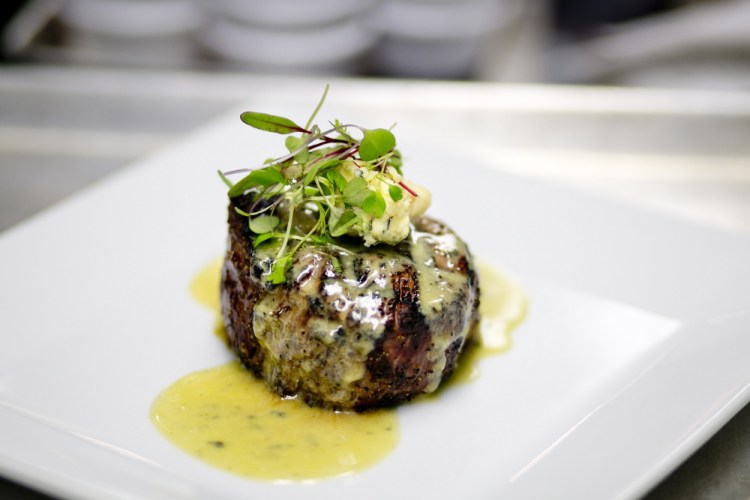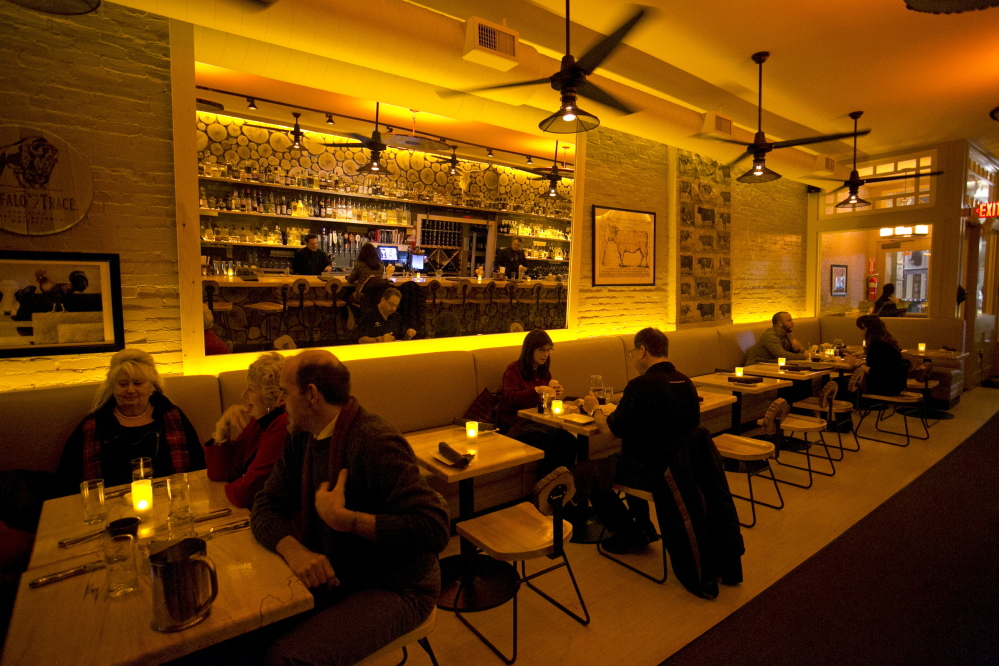Throw out your preconceived notions about traditional steakhouses – how they look and what they serve. Timber, a steakhouse and rotisserie that opened last May on Exchange Street, is barking up an entirely different kind of tree.
Walking through the front door is like entering the workshop of a forester, albeit one with highly refined taste. Instead of conventional leather banquettes and starched white tablecloths, there are slices, slivers and slabs of wood everywhere: topping the tables, polka-dotting the length of the back wall, standing in for seatbacks, even hanging overhead, where thick sections of red maple form baffles that throw light onto the ceiling. “I designed the dining room myself,” says Noah Talmatch, who owns Timber with his older brother, Dan. (They also own The North Point on Silver Street.) “Our goal here was to give Portland something completely different – a restaurant specializing in steak fare where you can also feast with your eyes.” And they have succeeded. The arboreal space in the Old Port is mesmerizing, and the same attention to detail that elevates the interiors infuses the food.
Take the Tuna Tataki starter ($18) – yes tuna – another indication that this is not your standard steakhouse. Seared ahi crusted with a mixture of peppercorns and sesame seeds is sliced thin, then fanned out like a dealer’s deck and served atop vivid green seaweed dressed in a soy-orange-ginger reduction. The presentation is unexpected – more sushi bar than steakhouse – but the play of textures is familiar: warm, silky tuna against cool, crunchy seaweed. And the taste? I closed my eyes and savored the flavors, first the clean brininess of the tuna and the delicate nuttiness of the sesame seeds, then the salty bite of decorative pearls of flying fish roe, then the fire of black pepper and paper-thin slices of jalapeño, and finally the spicy sweetness of the dressing. I found myself offering – no, demanding – that my friends try a bite.
A tomato and frisee special ($8) proved almost as delicious. A handful of slightly bitter greens was marinated with cherry tomatoes in extra-virgin olive oil, cracked pepper and sea salt until the frisee wilted slightly. The vegetables were then tossed with shavings of truffled asiago cheese; every now and then the scent of black truffles floated up from the plate, elevating a plain dish into a luxurious surprise. (Traditionalists need not worry. If you crave the customary, you can start with an excellent Caesar salad ($13). “Are you sure this is really a steakhouse?” we asked our waitress.
Two entrées answered the question: slow-roasted rotisserie chicken and filet mignon, steakhouse staples, both of which proved deeply flavorful and deeply satisfying. First the steak, a plump 10-oz. Black Angus filet priced at $41 but worth every marbled, bloody cent. This was the beef of dreams, impeccably seared and cooked to medium as requested, topped only by a scoop of creamy English Stilton. I easily wielded the steak knife (the stuff of tradition, suitable for slicing a filet or carving a path through the jungle) through the buttery meat – slightly crunchy and charred at the edges, richly red and juicy inside. Each bite had the concentrated flavor of U.S. Prime: no Select or Choice on the menu here. Kudos to Timber for serving this steak solo. Sure, you can order a side, and the Sautéed French Green Beans and Bacon ($8) we tried were tasty, but you won’t miss them. The beef is the star of this show.
I also liked the rotisserie chicken (offered half, $19; or whole, $28). At first glance I worried that the bird was undercooked; the skin seemed pale, but I was wrong. The meat proved moist and tender and nicely seasoned. (“We brine the birds for 24 hours then cook them in a vacuum-sealed rotisserie,” Noah Talmatch explains, “only throwing them under the broiler at the last minute to crisp the skin. That’s why they look so different and taste so moist.”) You could dip into any of the sauces offered alongside, from Bernaise to Thai Peanut, but why would you want to mask flavor this good? “If I didn’t have proper manners,” one friend told me, “I’d pick this up in a heartbeat.” She does – and she did.
I’m glad we didn’t revert to steakhouse form and order baked potatoes, although they are on the menu with sour cream, butter and chives ($6). Instead, we followed the terrific waitress’ suggestion and tried a paper cone of hand-cut french fries ($7) served with Parmesan-truffle aioli. Normally, I focus on fries and treat the condiment as an afterthought, but these spuds – though brown and crunchy and wonderfully salty – were mere vehicles for aioli, a mayonnaise so aromatic and intense that I practically asked for a ladle.
I have just a few quibbles with Timber. The night we visited a handful of tables were full, but the acoustics were bright; it’s possible that a full house will require raised voices. (If you’re hoping for a quieter setting, go early.) Also, top-of-the menu items are delicious and pricey – Black Angus Steak au Poivre, for example, is $49 – while less expensive items, such as the beef burger with Portobello mushrooms ($21), are just okay. Ditto New York cheesecake from Junior’s ($11), a bland slice that was smooth without being creamy and served too cold to really taste or enjoy. Much better is Timber’s Crème Brûlée ($11), with the thinnest possible glazing of burnt caramel over a dense, custardy filling. This crème is served with slices of strawberry soaked in bourbon – a boozy counterpoint to the sweetness of the custard. (Talmatch is proud of the spirits he showcases: “We have the largest selection of bourbons, scotches and ryes in the state,” he says. “The only place with more is the New Hampshire Liquor and Wine Outlet.”)
There’s a place for the time-tried and the familiar in all our lives – especially at this time of year. But every now and then we need to branch out, go against the grain and try a new twist on tradition. That’s Timber. It’s well worth a trip.
James H. Schwartz has covered food, travel and architecture for The Washington Post, Downeast, Coastal Living and Southern Living magazines for more than 30 years. Long a commuter between Portland and Washington, D.C., he retired from his job as vice president at the National Trust for Historic Preservation in 2013 and relocated to Maine.
Send questions/comments to the editors.




Success. Please wait for the page to reload. If the page does not reload within 5 seconds, please refresh the page.
Enter your email and password to access comments.
Hi, to comment on stories you must . This profile is in addition to your subscription and website login.
Already have a commenting profile? .
Invalid username/password.
Please check your email to confirm and complete your registration.
Only subscribers are eligible to post comments. Please subscribe or login first for digital access. Here’s why.
Use the form below to reset your password. When you've submitted your account email, we will send an email with a reset code.